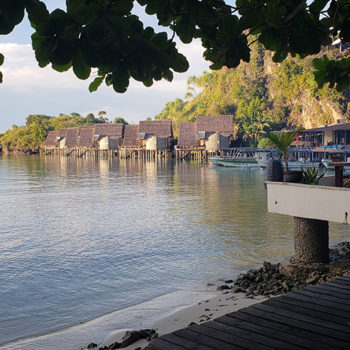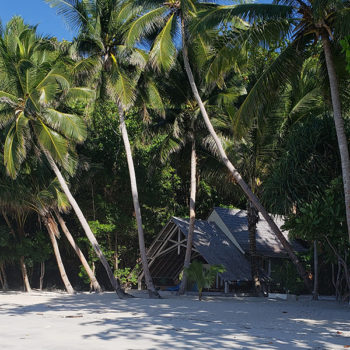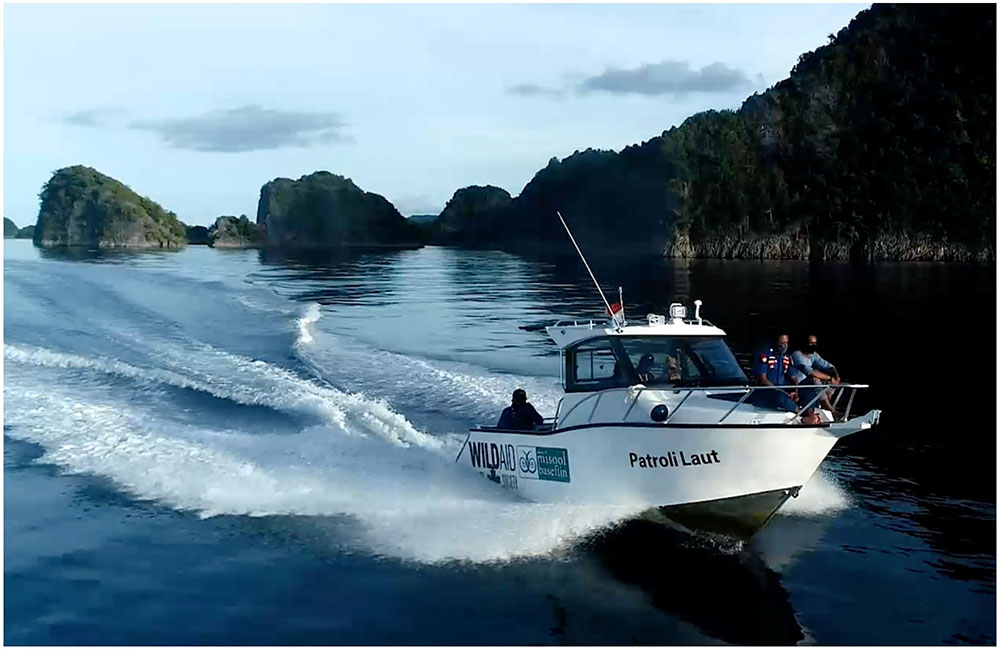Update: November 2020
Project title: Daram Island ranger post, ranger accommodation, patrol boat and research centre
OBJECTIVE 1: RANGER BASE CAMP AND ACCOMMODATION BUILDING
OBJECTIVE 2: NEW PATROL BOAT TO IMPROVE SURVEILANCE ACTIVITY IN DARAM
Accomplishments:
Ranger Base Camp and Accommodation Building – For 8 years, the ranger base camp in Daram had been supporting the rangers carrying out surveillance, but it fell into very poor condition. The wood structure was obsolete and the roof had many leaks. The time came to replace the run-down base camp with a new facility that would provide the rangers what they need to work effectively.
Thanks to WildLife Canada Society simple accommodations were constructed, allowing Misool to increase the number of rangers from 4 to 9, meaning that personnel could be rolled in and out without ever having the base camp empty.
The two-unit building (ranger post and accommodation facility) is operational at Mustenge Island, and includes offices and accommodations.
Additionally, furniture such as meeting table, guest chairs, cupboards, working tables, and bunk beds for all of our rangers have been installed.
New Patrol Boat to Improve Surveillance Activity in Daram No Take Zone – The easternmost areas of the Marine Reserve (The Daram Islands) are the ones most impacted as they are the furthest away from the Misool Resort and Misool Foundations central ranger base camp. Typically, the dive and snorkel boats based at the resort, act as “eyes on the water” and increase the effectiveness of the Rangers patrols nearest to the resort. However, the rangers based in the eastern “Daram Island” area, do not have this additional support (due to distance) and a larger ranger team was needed to ensure they function effectively.
Budget constraints and lack of a patrol boat that can handle rough sea conditions has seen the availability of the rangers at the Daram base camp drop to 65%. We wanted to improve our surveillance and patrol performance and activities at Daram Marine Reserve with an addition support of a new patrol boat.
Thanks again to WildLife Canada Society, our new boat is operational in the Daram area and we believe all the keys aspects and specifications required have been fully met.
The boat is named “samaga” which is the local name for sawfish, a fully protected species in Indonesia since 1999, and previously is the one of the species targeted by fisherman operating within the Daram Marine Reserve.
The number of daily patrol trips also increased significantly once the patrol boat became fully operational in October with the monthly patrols almost doubling from 28 to 42 patrols. The number of violations recorded increases as with the new patrol boat we could increase our area coverage during each patrol trip even in rough conditions and so we are increasing the number of interceptions. These metrics show that the support from WildLife Canada Society to improve the base camp facilities has increased attendance at the base camp and the new patrol boat has enabled patrols to cover a greater distance in worse conditions allowing an increase in interceptions and hence protection of the marine park.
Misool Founder and Managing Director, Andrew Miner shared the following:
“The patrol has been operating better than ever, and the facilities and new patrol boat has made a huge difference. The morale of the team is great and attendance at the base camp is now 100%. The patrol boat is what was desperately needed and the number of patrols nearly doubled in October when the boat became fully operational, as the team could patrol in much rougher weather. That and an ability to cover more distance safely and in more comfort lead to an increase in interceptions of illegal fishers, hence resulting in a better protection for the marine park. Thank you so much once again for all the support that WildLife Canada has given to Misool Foundation. Its really made a huge difference!”
Here is a video showing the new patrol boat in action in Daram.
UPDATE: July 2019
Joe Duff

In Indonesia, there is a tiny island, not even a mile long and a half-mile wide. It is one of many in the Ceram Sea but unlike most of the others, this one has a beach, making it accessible. Not long ago, that same beach was the base camp for shark fishermen who cut off their quarry’s fins for shark fin soup, which is an Asian delicacy and traditional status symbol. Only three percent of the shark was used. The animal was then tossed back into the sea, often, still alive. Those fishermen also threw dynamite into the water, making it easy to collect the stunned fish but destroying the coral reef in the process.
Andrew Miners stumbled into this tortured paradise and decided something had to be done before it was completely ruined. He and his wife, Marit worked with the local villagers and were granted a long-term lease and eventually created a 300,000 acre no-take-zone. In order to police that protected area and ensure the reef had time to recover, they established a fisherman’s cooperative and provided small business loans to the community. They hired a team of rangers to patrol the refuge. Many of them are ex- shark finner’s but they had to somehow pay them.
On the beach where thousands of sharks once died, they built a diving resort from scratch. They sawed reclaimed drift logs into timbers with a second-hand mill. Not one tree was cut down to build their cottages on stilts. Local artisans thatched the roofs and the foundations were made of hand-mixed concrete. Wood scraps and end cuts were used to make all the live edge furniture. Electricity is generated by solar panels and water is desalinated for guests who arrive via a four-hour boat trip from Sorong and stay for a week at a time.

In under ten years the wildlife returned; the coral recovered, and the Misool Marine Preserve is now the most bio-diverse reef in the world. There are over 600 species of coral – compared to the 58 types in the Caribbean. The shark population has increased by 600 percent along with thousands of other aquatic species; with more discovered every year. Guests can snorkel with sea turtles and jellyfish or float over fields of coral like underwater gardens. Divers can swim with oceanic mantas with fifteen-foot wingspans or forty-foot whale sharks. The Misool Eco Resort is now one of the world’s premier diving facilities and donates most of its profit to the Misool Foundation which works with local law enforcement and the Indonesian military to guarantee no one fishes within the no-take-zone.
WildLife Canada Society is pleased to assist the Misool Foundation by funding their manta research in the Savu Sea. To determine the distribution and extent of the manta population, DNA samples were collected; mantas were tagged with satellite tracking devices, and photos were taken of their distinctive belly markings. All of these data will provide a better understanding of the health of these magnificent animals.




